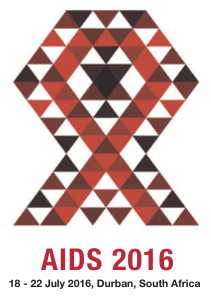High risk of virological failure and loss to follow up postpartum in South Africa
1 October 2016. Related: Conference reports, Pregnancy, World AIDS 21 Durban 2016.
South African HIV positive women are at risk of loss to follow up and virologic failure postpartum according to findings from a large study conducted in Johannesburg. Young women who conceive on ART are at higher risk of virological failure but more likely to remain in care compared with those who start ART in pregnancy.
There are limited data on postpartum loss to follow up and virological outcomes. At AIDS2016, Dorina Onoyal from the University of Witwatersrand presented results from a retrospective cohort study to examine the effect of timing of ART initiation before and during pregnancy on the risk of virological failure and loss to follow up in the first two years postpartum.
The study included 6971 women: 3068 (44.0%) controls (no record of pregnancy), 1968 (28.3%) incident pregnancies (conceived on ART) and 1935 (27.8%) prevalent pregnancies (ART started in pregnancy). Participants were aged 15 to 49 years, and started ART at 10 public clinics between 2004 and September 2014.
Women in the prevalent pregnancy group were more likely to be younger (52 vs 33%), have CD4 count <350 cells/mm3 (49 vs 29%) and to be anaemic (41 vs 20%), compared to those in the incident pregnancy group. A higher proportion of women with incident pregnancies had a single unsuppressed viral load result (30 vs 26%).
The investigators assessed the incidence and predictors of virological failure (two consecutive viral load>1000 copies/mL) and loss to follow up (>3 months late for a scheduled visit) during 24 months post-delivery or equivalent time (in controls) using Cox proportional hazards modelling. Virologic failure and loss to follow up were assessed separately.
Overall 563 (8.1%) women had postpartum virological failure at a rate of 5.0 per 100 person-years (95% CI 4.6-5.5) (crude rates): control group 5.0 per 100 person-years (95% CI 4.5-5.7); incident pregnancy group 5.7 per 100 person-years (95% CI 5.0-6.6); and prevalent pregnancy group 4.2 per 100 person-years (95% CI 3.5-5.0). Most failure occurred in women with low CD4 counts.
Virologic failure increased with years since delivery. Women in the prevalent pregnancy group with CD4 count <350 cells/mm3 and those in the incident pregnancy group with CD4 count >350 cells/mm3 at delivery had faster time to virological failure.
Predictors of postpartum virological failure among the incident pregnancy group were: anaemia at delivery, aHR 1.5 (95%CI 1.1- 2.1); WHO stage 3 at delivery, aHR 1.6 (95% CI 1.1- 2.5); and virological failure in pregnancy, aHR 2.1 (95% CI 1.5-3.0). Older age (30-39), aHR: 0.6, (95% CI 0.3-1.0) and CD4 count >350 cells/mm3 at delivery, aHR: 0.2 (95% CI 0.1-0.3) were protective against virological failure.
Among the prevalent pregnancy group, the only predictor was a higher CD4 count (>350 cells/mm3) at delivery, which was protective against postpartum virological failure, aHR 0.3 (0.2-0.6).
Overall 1645/ 6971 (23.6%) of women were lost to follow-up at 24 months at a rate of 8.6 per 100 person-years (95% CI 8.2-9.0): control group 23%, 8.4 per 100 person-years; incident pregnancy group 19.4%, 6.5 per 100 person-years (95% CI 5.9-7.2); and the prevalent pregnancy group 27.9%, 11.2 per 100 person-years (95% CI 10.3-12.2).
Dr Onoyal noted that women in the prevalent pregnancy group tended to be lost to follow up earlier at a median time of about 9 months. The same group experienced viral failure at a median time of almost 12 months – so many will be lost before this can be determined. So although these women might appear to have a lower risk, they do not stay in the system long enough for postpartum viral failure to be recorded.
Predictors of loss to follow up in the incident pregnancy group were: lower education level (did not complete secondary school), aHR 1.6 (95% CI 1.0-2.5); receiving care at primary health facility compared to hospital based clinic aHR 1.7 (95% CI 1.3-2.1). But receiving care through an NGO was protective: aHR 0.7 (95% CI 0.5-1.0). Neither age nor any of the health indicators at baseline were predictive.
In the prevalent pregnancy group, similarly, educational level and clinic type were predictive of loss to follow up. Younger age (30 to 39 vs <25 years), aHR 0.8 (0.6-1.0) and being unemployed aHR 1.2 (1.0-1.4) were predictive. And women who received 7 months or more antenatal ART were more likely to be retained than those who received 3 months or less, aHR 0.4 (0.3-0.7).
Dr Onoyal concluded that young women who conceive on ART are a higher risk of postpartum viral failure but are more likely to remain in care, “so we can do something about it”. Virologic failure seems so be associated with poor health at delivery, which might be the result of poor outcomes during pregnancy, she explained.
Women who conceive during pregnancy need adherence and support interventions targeted to the ART experienced. And women who start ART during pregnancy – who are more likely to be lost to follow up postpartum – need strengthened adherence and support programmes particularly among those diagnosed in the third trimester or at delivery.
Comment
This report highlights the huge importance of extra support for HIV positive women on ART in the postpartum period.
Reference:
Onoya D et al. Timing of pregnancy among HIV-positive women, postpartum retention and risk of virologic failure. 21st International AIDS Conference. 18-22 July 2016. Durban South Africa. Oral abstract WEAB0102.
http://programme.aids2016.org/Abstract/Abstract/8509 (abstract)
https://www.youtube.com/watch?v=OApOW1BBobQ (webcast)


